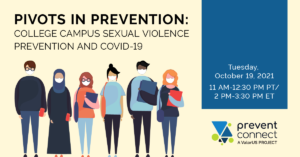Coming Back to Campuses: Key Takeaways from Two Recent Web Conferences
Many students, staff, and faculty have been back on campus since this fall for the first time since the start of the COVID-19 pandemic in the United States. This has presented many challenges and opportunities for sexual and intimate partner violence prevention on campus, and campus preventionists are curious about ways to do prevention differently. PreventConnect hosted two web conferences this fall focused on prevention within higher education communities: A Conversation with the Authors of Sexual Citizens: A Landmark Study of Sex, Power, and Assault on Campus and Pivots in Prevention: College Campus Sexual Violence Prevention and COVID-19. These web conferences provided different insights and strategies to prevent sexual and intimate partner violence on campuses and engage partners, but there were a few common themes throughout.
 Prevention takes many different forms, but always needs to be rooted in equity.
Prevention takes many different forms, but always needs to be rooted in equity.
Jennifer Hirsch and Shamus Khan, co-authors of Sexual Citizens: A Landmark Study of Sex, Power, and Assault on Campus and presenters on A Conversation with the Authors of Sexual Citizens: A Landmark Study of Sex, Power, and Assault on Campus, stressed the importance of multiple modalities of sexual and intimate partner violence prevention. These modalities can often be related to the three major concepts explored in Sexual Citizens: sexual geographies (features of a space and who controls it), sexual projects (what sex is for), and sexual citizenship (honoring one’s own and others right to sexual self-determination).
Huvona Watkins describes her work to train and recruit healthcare workers at a local community college to prevent sexual and intimate partner violence prevention on the web conference Pivots in Prevention: College Campus Sexual Violence Prevention and COVID-19. This form of prevention acknowledges that students can both be the prevention population and also leaders in shaping sexual and intimate partner violence prevention in their communities. mariana matthews discussed a similar theme during their presentation in the same web conference; in addition to the prevention programming students participate in, like a gender-inclusive adaptation of Coaching Boys Into Men, students are also trained to be local leaders in sexual and intimate partner violence prevention. This process starts by consulting students on their prevention needs, what they’ve done previously, and any gaps or opportunities for prevention they’d like to address.
All of the presenters across both web conferences also stressed the importance of grounding sexual and intimate partner violence prevention work in health equity, racial justice, and anti-oppression. Jennifer and Shamus discuss an example of how white supremacy and patriarchy fuels who has access to and power over social spaces, influencing who is at risk of experiencing sexual violence. This calls on the need to not ignore systemic oppression when looking across sexual geographics, sexual projects, and sexual citizenship to prevent violence. Huvona described how she centers her sexual and intimate partner violence prevention trainings with student community health workers in health equity and uplifted two new resources: Back to Basics: Partnering with Survivors and Communities to Promote Health Equity at the Intersections of Sexual and Intimate Partner Violence and A Health Equity Approach to Preventing Sexual Violence. mariana discussed how promoting inclusivity, equity, and empowerment is a strategy for prevention at UC Berkeley and provided examples of how this shows up in her prevention work.
 Prevention requires partnerships.
Prevention requires partnerships.
Sexual and intimate partner violence prevention work is often siloed, and preventionists are familiar with the need to break down those silos. Jennifer and Shamus discussed during their web conference a need to think differently about who to partner with to prevent sexual and intimate partner violence on campus. They gave an example of a partnership with campus housing and dining services that filled a gap for preventing violence on campus. By keeping the dining hall open late at night, students now had an option to socialize in a space that does not carry a heavy expectation of sex like dorm rooms might. Jennifer and Shamus also use this example to explain how no singular prevention intervention will prevent all sexual assaults or experiences of dating violence, but broadening the pool of prevention partners and activities creates a great safety net and options for students.
Huvona provided insight into how and why community health worker students make great partners in sexual and intimate partner violence prevention, and the partnerships required to reach the students, too. Community health workers are deeply imbedded in their communities and highly trusted messengers, two traits that are critical to preventing sexual and intimate partner violence. mariana also described the many partnerships that make prevention possible at UC Berkeley and how this infuses a culture of care throughout the campus community. This influences community values about prevention, and can serve as a mechanism of social norms change to prevent sexual and intimate partner violence perpetration.
Campus prevention should happen throughout the lifetime and off-campus, too.
Jennifer and Shamus explain how many of the issues campuses face when it comes to sexual and intimate partner violence prevention could be due to the fact that for many, their first exposure to prevention or sex education could be when they start their higher education journey. This is not a pass to give up on prevention on campus, but a call to parents, K-12 educators, coaches, and other influential adults like policymakers to prioritize sexual and intimate partner violence across the lifespan.
The community health workers who are engaged in sexual and intimate partner violence prevention are doing so in the community, off-campus. Huvona describes how this allows them to infuse health equity into prevention and into communities, since the student community health workers are learning about both through their prevention training and their school training. The lifetime of students can often feel short, as many campuses may experience a total student population turn over every few years. mariana explains the importance of institutionalizing prevention, meaning prevention is engrained in policies, practices, and campus culture that expands beyond students’ tenures and into their respective communities.
Find the recordings, slides, and resources from these two campus-focused web conferences below:
